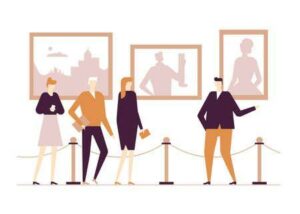By Syd Overtoom (he/they)

I find this to be a good example of a group being led on a guided tour. The visitors are engaged as the docent appears to be leading the conversation about one of the works, which is key to this kind of program.
Are you considering a museum career path? Have you been inspired by a museum education program or two to pursue this world of amazing work? Me, too! I’ve loved the different programs and educational materials I’ve experienced over the years. As we learned this week from Bonnie Sachatello-Sawyer et al. and others, museum programs come in a range of formats. From classic lectures and guided tours to school curriculum guides and community events, there is something for everyone. Programs are an essential part of museum education, and today we took our first big step into program planning by exploring the program development process.
Throughout the semester, our class is working in small groups to create and implement a set of educational programs and resources for the Indianapolis community related to the mission, values, and themes of the Museum of Broken Relationships (MBR). In the words of co-founders Olinka Vištica and Dražen Grubišić, each of MBR’s community-based, crowd-sourced exhibits “is a collection of items and stories that were donated by people after their relationships fell apart” and a place where those stories can be experienced by others. Through our programs, we aim to provide different target audiences with opportunities to further engage the ideas of love, loss, and change as reflected in the Museum of Broken Relationships Indianapolis exhibit.
Of course, there are many things we must consider as we plan our programs. Rebecca Martin’s helpful article, “The Nuts and Bolts of Program Management,” details quite the list, like identifying audience needs, deciding what you hope to achieve with your program, recruiting staff and/or volunteers, and securing the most effective space and location for the program. Luckily, a preliminary set of target audiences and program formats have been provided to us. While subject to change, our programs currently include:
- a panel presentation for adults 18+ from community and campus
- a hands-on experience for families
- a classroom resource for Indianapolis high school teachers and students
- a memory-sharing resource for older adults
- an arts-based workshop for teens and older
- a resource for pairs of exhibit visitors to spark conversation
As a member of the high school classroom resource team, I think it’s important that our program materials help students express their feelings about loss and love in meaningful ways. To meet teachers’ needs, we must also link our materials to the State of Indiana curriculum standards, ideally across multiple subjects, like Social Studies, English, and/or Health.
After considering audience needs, another key step of program development is writing program outcomes. As described by the Institute of Museum and Library Services, outcomes are the “achievements or changes in skill, knowledge, attitude, behavior, condition, or life status” we’ll aim to foster for program participants. As Wendy Kekahio and her team lay out, outcomes can be short-term, mid-term, or long-term, depending on both the targeted change and its time frame. For many museum programs and resources, short-term outcomes are the most achievable. For example, a short-term outcome I might propose for our high school resource is that right after completing a particular activity, students will reconsider what love and loss can look like. This immediate change in attitude is one we can then evaluate, perhaps with a short survey.
As we work out our specific program outcomes, we must ultimately align with the main goal of the Museum of Broken Relationships Indianapolis collaborative project: to engage participants in reflection on and learning about the ways that we love, lose, and change through relationships. Hopefully our programs will help meet this project goal.
Maybe now you’re also inspired to investigate museum program development. Stay tuned for updates as our work continues.
Syd Overtoom is a first-year graduate student in the Museum Studies program at IUPUI, with a great interest in museum education.

